Don’t Change a Day Trade to a Swing Trade
In my first book, “How to Day Trade for a Living”, I introduced a rule that a day trader must close their position at the end of the day, even at a loss. You should never turn a day trade into a swing trade and hold your position overnight. This did not resonate with all traders. Roy, a reader of the first book, wrote a review, included as Figure 7.1, saying:
“The really big thing is to get out of your trade at the end of the day. Vamos!”
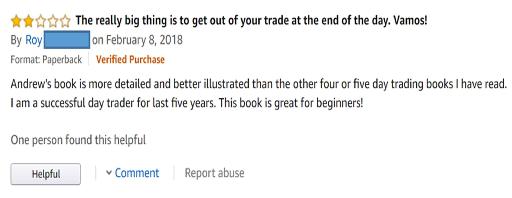
Figure 7.1 - Amazon review of my first book (https://goo.gl/z75x6A).
Sorry Roy, but I still stand by my opinion. A successful day trader follows their well-thought-out in advance trading plan based on the rules of the strategy they have chosen for that particular trade, and this is one of the challenges you will face when in a bad trade. You may very likely find yourself justifying staying in a bad trade by saying, “Well, you know, it's Apple, and everybody knows how successful they’ve been. They're definitely not going out of business. I'll just hold this for tomorrow and see how it goes.”
This is one of the deadliest sins a day trader can make. You do not want to do that. You must follow the rules of your strategy. You must follow the trading plan you prepared prior to entering the trade. You can always get back in, but it’s hard to recover from a big loss. You may think, “I don't want to take a $50 loss.” Well, you definitely don't want to take a subsequent $200 loss. And if you ended up taking an $800 loss, it would be really hard to recover from that. Take the quick losses, get out, and come back when the timing is better.
Of course, I am not against holding shares of Apple overnight, or any other stock for that matter. There is nothing wrong with holding positions for a few days and much money can be made on the market from doing that. But if you plan to trade overnight, you need to remember that now you are making a swing trade, and swing trades have their own rules and considerations. You should never turn a day trade that goes bad into a wishful swing trade. It often does not end well. You may get lucky a few times and the stock will bounce back, but the market will eventually punish you if you get into the habit of having a “holding it a bit longer” type of attitude. My friend Brian in our chatroom often holds many stocks overnight, but he purposely holds them overnight, and only after reviewing daily charts, market conditions and many other details. He never keeps a losing position just because he got stuck in a bad trade.
I want to share with you a couple of emails I received from traders. They’re good examples of the challenges new traders face. Trader Sean’s first email to me read:
“Hey, how are you? I am an ironworker and want to get into day trading. I already started about 5 months in trading. I read your book and it was helpful, but there are a few things I still don’t understand and hoping you can assist me. Don’t mean to intrude on your time. Thank you.”
Like everyone does, I receive many emails every day. I always try to find the time though to answer questions from new traders as I enjoy those exchanges. I asked Trader Sean how I might help him and then I learned what I was afraid of. He was looking for my opinion about a few bad trades that he got stuck in.
“I have 4 position[s] open and I'm down on all of them. My account is not allowing [me] to day trade. I'm currently allocating funds to day trade. Do you think I should hold the position until they are back up or should I cut my losses? These positions are holding up more than 50% of my account.”
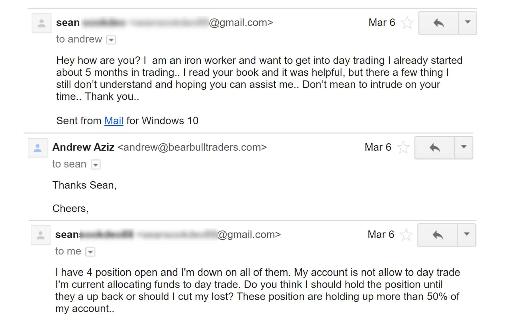
Figure 7.2 – Emails from a trader seeking advice.
Unfortunately, I could not help him. I do not know enough about Trader Sean to provide any sort of meaningful advice. How big is his position? How big is his account? How old is he? Does he have a family? Is this money his retirement account or money that he can afford to lose? I was not in a position to offer any advice. What I might personally think is irrelevant. I advised Trader Sean to talk to a qualified and licensed advisor and seek professional guidance for his position. His two emails are reproduced above as Figure 7.2.
Another example was a trader who I know for a fact is also a medical doctor. Let’s call him Trader MD. His email is reproduced as Figure 7.3. He emailed me and explained a trade that went bad and asked for advice:
“Hello Dear Aziz,
“I read your book, it is very useful and enjoyable.
“I am a swing trader (beginner). I did a big mistake, I need a strategy to recover my lose, can you please give me a strategy that can help.
“I bought a stock GBTC (Bitcoin Investment Trust), I invested $55,000, currently I am losing $15,000 due to current bitcoin crush. I have been waiting for bitcoin to recover, but every day my loss gets bigger, what should I do? Should I sell everything or should I buy/sell to bring the breakeven down? What would be your suggestion?”
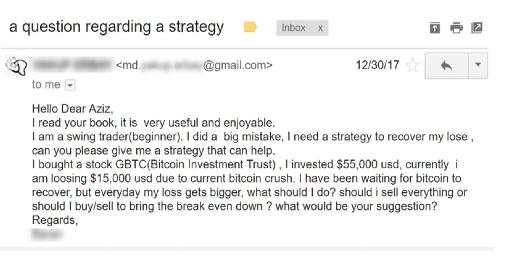
Figure 7.3 - Trader MD’s emailed questions.
Back in December 2017, Bitcoin was being traded at up to around $20,000. GBTC was being traded at an all-time high of around $40. Figure 7.4 is a daily chart for GBTC for around this time frame. Trader MD emailed me on December 30, 2017, so I assume he must have got into the trade at around those prices. “Bitcoin mania” burst in January 2018 and it dropped to as low as $6,900 on February 5, 2018. Therefore, GBTC also dropped, from a high of $40 to below $10, as GBTC essentially tracks the price of the Bitcoin. At the time I am writing these sentences in March 2018, GBTC is being traded at around $17. Again, I sympathize with Trader MD, but he should have never let this happen in the first place. He did not have a proper risk management plan and ended up gambling his savings on GBTC.
When you enter into a trade, no matter if it is a swing trade or a day trade, you need to define your entry, your exit and your stop loss. Every time you trade, you’re exposing yourself to the risk of losing money. How do you minimize that risk? A common reason for the failure of new traders is their inability to manage losses. Accepting profits is easy to do, but it is much more difficult, especially for beginners, to overcome the temptation to wait for losing trades to return to the break-even point. Waiting for something that is not likely to happen can result in serious damage to your accounts, as I guess it did to Trader MD. You must define a proper entry, profit target and stop loss and then, if the trade goes against you, exit it. You are much more apt to manage your losses if you stick to your plan and under no circumstances risk more than 2% of your account with any trade.
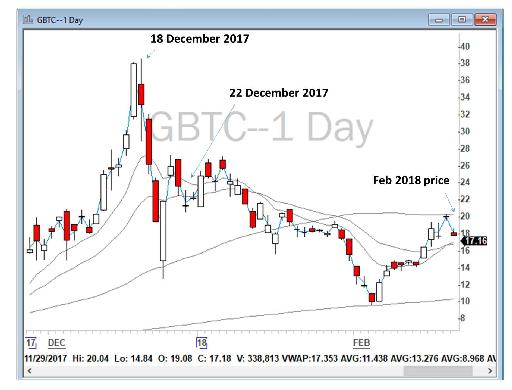
Figure 7.4 - Daily chart showing price variations in GBTC.
This example also shows the importance of sound psychology and self-control for traders. I am sure many readers remember the “tulip mania” of Bitcoin at the end of 2017. Tulip mania refers to a period in the 17th century, during the Dutch Golden Age, when the Netherlands was the world's leading economic and financial power. At that time, the prices of some fashionable tulip bulbs reached extraordinarily high levels and then in February 1637 dramatically collapsed, essentially becoming the first recorded speculative bubble, which is when the prices of assets or commodities deviate considerably from their real intrinsic values. Tulip mania, similar to the cryptomania craze of 2017, was more a socio-economic phenomenon than a major economic issue or crisis, as tulip bulbs were not a significant part of the Dutch economy, just as cryptocurrency is not (yet at least!) a significant part of our global economy.
Similarly, in 2017, ordinary people, uneducated investors, and people with limited financial literacy were rushing to buy cryptocurrencies. The market was unbelievable. The blockchain stocks were the hot new thing. The value of companies who simply mentioned the word “blockchain” in a press release would skyrocket. For example, a company called “Long Island Iced Tea Corp.” (ticker: LTEA) changed their name to “Long Blockchain Corp.” (ticker: LBCC) and decided to shift their focus from beverages to blockchain technology. The stock ran nearly 500% in a single day, as you can see in Figure 7.5. The company’s shares moved from below $2 to $9.47 with heavy trading volume. On April 10, 2018, LBCC was delisted by the Nasdaq, but is still available on the over-the-counter (OTC) markets. As of June 10, 2018, LBCC was being traded at $0.35 per share. The company has abandoned its plans to purchase Bitcoin mining equipment.
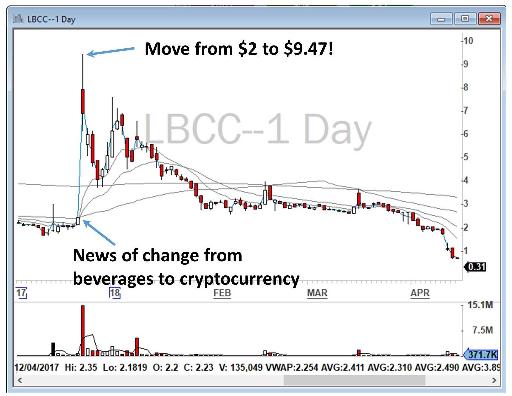
Figure 7.5 - Long Island Iced Tea Corp. (ticker: LTEA). In 2017, the corporation rebranded as Long Blockchain Corp. (ticker: LBCC) as part of a corporate shift towards "exploration of and investment in opportunities that leverage the benefits of blockchain technology" and reported that they were exploring blockchain-related acquisitions.
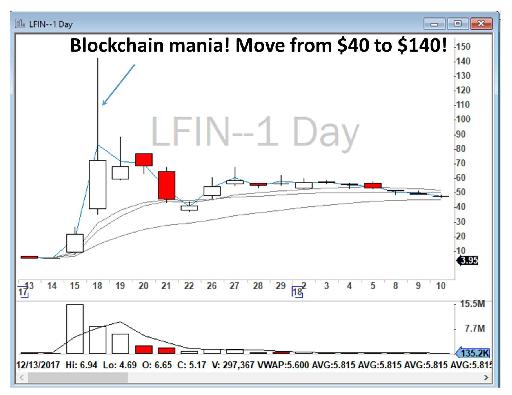
Figure 7.6 - Blockchain mania on Longfin Corp. (ticker: LFIN). LFIN is now de-listed from the Nasdaq and as of June 2018 is being traded at about $3.50 in the over-the-counter (OTC) markets.
Rational? No, but this was the theme at the time, as many blockchain stocks were experiencing similar moves. Figure 7.6 highlights Longfin Corp. (ticker: LFIN), another company that was established in December 2017 and made headlines when its stock price increased more than 200% from $40 to over $142 in 1 day, a move of over 300%! LFIN’s price later fell by over 95% and as of June 10, 2018 is being traded at $3.75 per share in the over-the-counter markets. Many analysts and Wall Street research firms called LFIN a 'pure stock scheme’. The Securities and Exchange Commission (SEC) started an investigation into the company as filings and press releases were “allegedly” riddled with inaccuracies and fraud.
Many ordinary investors such as Trader MD were victims of 2017’s cryptomania, investing perhaps a lifetime of savings into something that they had developed absolutely no risk management plan for.
A novice trader with a feeling of missing out, perhaps such as Trader MD, will get slaughtered eventually. Don’t get me wrong. I am not against Bitcoin or cryptocurrencies, nor do I believe that they have no intrinsic value. The blockchain may indeed one day revolutionize the financial market, but those prices back in 2017 were mostly speculative. There is nothing wrong with trading Bitcoin. A lot of money was to be made amid the volatility, but experienced traders knew that they were only trading for the short term, and they had firm risk management rules in place. Experienced traders make their money, but they never let a bad trade turn into a ticking time bomb inside of their accounts. We in the chatroom were making thousands of dollars daily on cryptocurrency-related stock such as Riot Blockchain, Inc. (ticker: RIOT), Xunlei Limited (ticker: XNET), Advanced Micro Devices, Inc. (ticker: AMD), and NVIDIA Corporation (ticker: NVDA). We made so much money on XNET that in the chatroom we referred to it as, “XNET, our good buddy”. I recall a period when Brian traded NVDA every single day for almost 6 months.
Table of contents
- DISCLAIMER:
- Table of Contents
- Chapter 1: Introduction
- Chapter 2: The Trading Tools and Platform
- Chapter 3: Building Your Trading Watchlist
- Chapter 4: Support and Resistance Levels
- Chapter 5: Price Action, Candlesticks and Trade Management
- Chapter 6: Advanced Day Trading Strategies
- Chapter 7: Risk and Account Management
- Chapter 8: Conclusion and Final Words
- Glossary